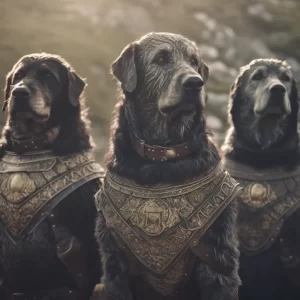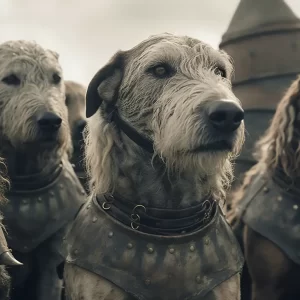Celtic Hounds, also known as Irish Greyhounds, were an ancient breed of sighthounds that lived in Europe during the 17th and 18th centuries. These large-sized dogs were used as battle companions for soldiers and to hunt both big and small game. They were known for their agility, speed, and hunting skills.
Celtic Hounds were an important part of Celtic mythology and folklore. They were believed to have magical powers and were often associated with the otherworld of Welsh myth. In Irish mythology, Cú Chulainn the legendary figure, was known as the hound of Chulainn, after he took up the duties of the guard dog he accidentally killed. These dogs were also depicted in art and jewelry designs dating back as far as the Iron Age.
Despite their popularity and importance in Celtic culture, the breed eventually became extinct. However, their legacy lives on through their depiction in art, literature, and mythology. Today, there are efforts to recreate the breed through selective breeding of similar sighthound breeds.
Celtic Hounds History and Mythology
Celtic Hounds in Mythology
Celtic hounds have been a significant part of mythology in many cultures. In Irish mythology, they were believed to be the guardians of the Otherworld and were associated with death and the afterlife. The most famous of these hounds was the legendary Cú Chulainn’s hound, which was said to be able to kill any foe in a single bite.
In Welsh mythology, the hounds were associated with the god Arawn and were said to be able to travel between the worlds of the living and the dead. They were also said to be able to sense the approach of death and would howl to warn their masters.
Celtic Hounds in History
Celtic hounds were also significant in Celtic history. They were often depicted in Celtic art and were a symbol of the Celtic tribes’ ancestry and bloodlines. They were also used for hunting and were prized for their speed and agility.
The Romans, who conquered much of Europe, were also fascinated by the Celtic hounds. They wrote about the Vertragus, a type of Celtic hound that was used for hunting and was highly valued for its speed and endurance.
When Christianity arrived in Ireland and Wales, the hounds were associated with Satan and were seen as evil creatures. However, many Celtic tribes continued to keep the hounds as pets and hunting companions.
In addition to their use in hunting, Celtic hounds were also a popular subject for jewelry. Many Celtic brooches and other pieces of jewelry were adorned with images of hounds, which were believed to bring good luck and protection to the wearer.
Conclusion
Celtic hounds have played a significant role in both mythology and history. They were associated with death and the afterlife in Irish mythology and were seen as symbols of ancestry and bloodlines in Celtic history. Despite being associated with Satan by Christians, the hounds remained a popular pet and hunting companion among Celtic tribes. Their image was also a popular motif in Celtic jewelry.
Appearance and Temperament

Physical Appearance
Celtic Hounds are known for their impressive physical appearance. They are a large breed of sighthound, with long legs and a short coat that is usually brindle, fawn, or blue with dark spots. They can grow up to 32 inches in height and weigh up to 120 pounds.
Their muscular build and athletic appearance make them ideal for hunting and other physical activities. Their long legs enable them to run at great speeds, and their keen eyesight allows them to track prey with ease.
Temperament
Despite their imposing size, Celtic Hounds are known for their gentle and affectionate temperament. They are kind and loving with their families and are often calm and aloof with strangers. They can be shy at first, but once they warm up to someone, they can be quite playful and child-friendly.
Celtic Hounds are reliable and make excellent family pets. They are loyal and protective of their families, and their affectionate nature makes them great companions for children. They are also known for their calm and patient demeanor, which makes them easy to train and handle.
Hunting and Protection
Celtic Hounds were bred for hunting, but they also served as guard dogs and protectors. This section will explore the hunting and protective instincts of the Celtic Hounds.
Hunting Instinct
The Celtic Hounds were originally bred for hunting small game, such as rabbits and foxes. Foxes also play a large part in Celtic mythology. Their long, lean bodies and short coats made them agile and fast, which made them perfect for hunting. They have a strong hunting instinct that has been honed over centuries of breeding. Celtic Hounds have a keen sense of smell and incredible speed, which made them effective hunters in the past.
Guard Dog and Protection
In addition to their hunting instincts, Celtic Hounds also served as guard dogs and protectors. They were used as watchdogs, war dogs, and protectors of their owners and their property. They were fiercely loyal to their owners and would defend them at all costs. Celtic Hounds were known for their courage and tenacity, which made them effective protectors.
Celtic Hounds were often given as gifts to important personages and foreign nobles. They were highly prized for their hunting and protective abilities. King John of England, for example, presented an Irish hound named Gelert to Llywelyn, the Prince of Wales. The poet The Hon William Robert Spencer immortalized this hound in a poem.
Celtic Hounds were also used as war dogs in battles. They would be trained to attack enemy soldiers and to protect their own soldiers. They were highly valued for their bravery and loyalty in times of war.
Breeding and Extinction
Breeding
Celtic Hounds, also known as Irish Wolfdogs, were bred in Ireland for hunting purposes. They were believed to be the ancestors of the Scottish Deerhound, Greyhound, and Irish Wolfhound. The breed was known for its speed, agility, and strength. Celtic Hounds were a cross between the Irish Mastiff and the English Bulldog.
The breeding of Celtic Hounds was not regulated, which led to a lack of consistency in the breed. This inconsistency made it difficult to maintain the breed’s standard. Additionally, the breed was not recognized by any kennel club, which further contributed to its decline.
Extinction
Celtic Hounds went extinct in the 17th century due to a lack of conservation measures. The breed was not recognized by any kennel club, which made it difficult for breeders to maintain the breed’s standard. Furthermore, a large number of Celtic Hounds died during wars as they were often used in battle.
The extinction of Celtic Hounds was a loss to the dog world, as the breed was known for its gentle, affectionate, and kind temperament. However, their lineage lives on through their descendants, such as the Scottish Deerhound, Greyhound, and Irish Wolfhound.
It is worth noting that the extinction of Celtic Hounds is not unique. Many dog breeds have gone extinct throughout history due to various reasons such as lack of conservation measures, overbreeding, and changes in societal needs.

Famous Celtic Hounds
Irish Wolfhound
The Irish Wolfhound is one of the most famous Celtic hounds. This breed is known for its large size and strength and was used for hunting wolves and other large game. Irish Wolfhounds are also known for their gentle nature and make great family pets. They are loyal and affectionate and are often used as therapy dogs.
The Irish Wolfhound has a long history in literature and mythology. They were often depicted as noble and majestic animals, and were sometimes even considered to be sacred. One famous Irish Wolfhound was owned by Captain George Augustus Graham, who wrote extensively about the breed in the 1800s.
Scottish Deerhound
Another famous Celtic hound is the Scottish Deerhound. This breed is also known for its size and strength, and was used for hunting deer and other game in Scotland. Scottish Deerhounds are also known for their gentle nature and make great family pets.
Like the Irish Wolfhound, the Scottish Deerhound has a long history in literature and mythology. They were often depicted as noble and majestic animals, and were sometimes even considered to be sacred. In some legends, Scottish Deerhounds were said to be able to see into the future.
Other Famous Celtic Hounds
There are many other breeds of Celtic hounds, including the Greyhound and the Celtic Hound. These breeds were also used for hunting and were known for their speed and agility. In some cases, they were also used in battle.
Celtic hounds come in a variety of colors, including black, red, and white. They are also known for their sighthound abilities, which allow them to see prey from a great distance.
Still Popular Today
The Celtic Hound was an extinct breed of dog that is often referred to as the popular Greyhound. It is considered the ancestor of the Scottish Deerhound, Greyhound, and Irish Wolfhound. According to Irish mythology, they are also believed to protect and guide the lost souls in the other world or Heaven.
The Celtic Hound was a beloved companion of the ancient Celts, and it played an important role in their culture and mythology. It was a symbol of loyalty, courage, and strength, and it was often depicted in art and literature.
Despite its extinction, the legacy of the Celtic Hound lives on through its descendants, which are still popular breeds today. The Irish Wolfhound, for example, is one of the largest breeds of dog and is known for its gentle and friendly nature.
Frequently Asked Questions
What is the meaning of the Celtic hound symbol?
The Celtic hound symbol represents loyalty, protection, and guidance. The Celts believed that hounds had supernatural abilities and were able to guide souls to the afterlife. The symbol is often used in Celtic artwork and jewelry, and is also associated with the goddess Cerridwen.
Who were the hounds in Celtic mythology?
In Celtic mythology, hounds were often associated with the Otherworld and the afterlife. The most famous of these hounds was the Cúchulainn’s hound, which was said to be able to kill ten men in one bite. Other notable hounds include Gwyn ap Nudd‘s hounds, which were said to hunt the souls of the dead, and Arawn’s hounds, which guarded the gates to the Otherworld.
Are there any modern breeds related to Celtic hounds?
There are several modern breeds that are believed to be related to Celtic hounds, including the Irish Wolfhound, Scottish Deerhound, and Greyhound. These breeds are all sighthounds, which were used by the Celts for hunting and as war dogs.
What is the history of the Celtic knot design?
The Celtic knot design is a type of decorative knotwork that originated in the early Middle Ages. The knots are made up of interlocking loops and have no beginning or end, symbolizing the eternal nature of life. The knots were used in Celtic artwork and jewelry, and were also used to decorate manuscripts and other important documents.
What is the significance of dogs in Celtic culture?
Dogs were highly valued in Celtic culture and were often used for hunting, guarding, and as companions. The Celts believed that dogs had supernatural abilities and were able to see and sense things that humans could not. Dogs were also associated with the Otherworld and were believed to be able to guide souls to the afterlife.
Which Celtic deity is associated with canines?
The goddess Cerridwen is often associated with canines in Celtic mythology. She was said to have a pack of hounds that were able to guide souls to the afterlife. Cerridwen was also associated with the moon and was said to have the power to transform into a hound herself.


